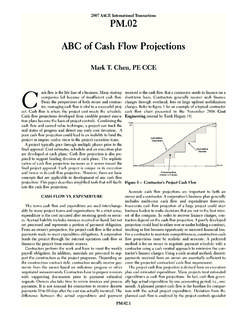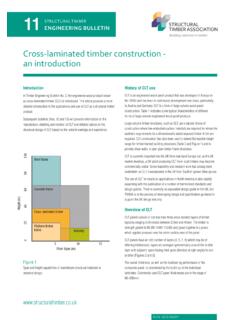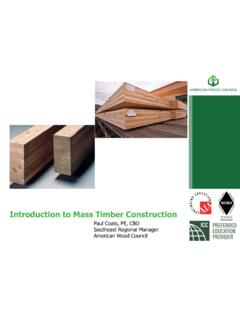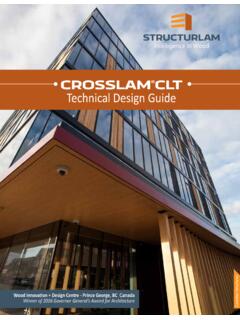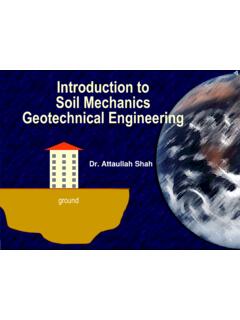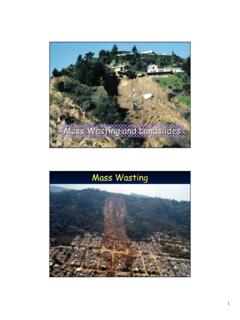Transcription of ALTERNATIVE CONSTRUCTION METHODS FOR LOW-COST …
1 ALTERNATIVE CONSTRUCTION METHODS FOR LOW-COST HOUSING IN SOUTH AFRICA Justin Haselau1 Compiled in 2013 A paper for the project management , quantity surveying profession 1 Honors student in Quantity Surveying and CONSTRUCTION Management, Department of Quantity Surveying and CONSTRUCTION Management, University of the Free, State, Box 339, Bloemfontein, 9300, South Africa. Phone: 051 4013322 Table of contents Page number 1. INTRODUCTION 1 2. ALTERNATIVE CONSTRUCTION METHODS 2 Moladi housing technology 2 Speedwall building systems 2 Hydraform interlocking bricks 2 Modular and timber CONSTRUCTION 3 Straw bale CONSTRUCTION 3 3.
2 METHODOLOGY 3 4. RESULTS AND DISCUSSION 4 Profile of respondents 4 Low cost housing CONSTRUCTION METHODS 4 ALTERNATIVE low cost houding CONSTRUCTION METHODS 5-6 General questions 7 5. CONCLUSION 7 6. RECOMMENDATIONS 8 REFERENCES LIST 8 List of Tables Page number Table 1: Profile of respondents 4 1 ALTERNATIVE CONSTRUCTION METHODS FOR LOW-COST HOUSING IN SOUTH AFRICA JUSTIN HASELAU Purpose: To compare ALTERNATIVE CONSTRUCTION METHODS for LOW-COST housing in order to identify the best method regarding cost, time and quality and improve the awareness regarding these METHODS . Method: A questionnaire survey on the familiarisation of ALTERNATIVE CONSTRUCTION METHODS and how the different CONSTRUCTION METHODS could be applied to the development and delivery of LOW-COST housing was conducted among quantity surveying firms and the Eastern Cape Department of Roads and Public Works.
3 Findings: There are ALTERNATIVE CONSTRUCTION METHODS that take less time and cost for building LOW-COST housing and that the lack of awareness regarding ALTERNATIVE CONSTRUCTION METHODS is a limitation in its application for LOW-COST housing. 1. INTRODUCTION Sixteen years into its democratic existence, the South African government is still struggling to provide adequate LOW-COST housing as set out in the several housing policies since 1994 (Charlton & Kihato, 2006: 275). Some of the weaknesses of the housing policy is that there is not a clear link between the current focus in government on the contribution of housing to poverty alleviation, and the ability of the policy to deliver on these objectives (Charlton & Kihato, 2006: 259).
4 This resulted in housing backlogs and poor quality low cost houses. South Africa s minister of human settlements, Mr. Tokyo Sexwale reports that the government housing backlog stands at million units, affected over eight million people. He also reports that around 40 000 RDP houses would have to come down because of poor workmanship (South Africa Info, 2010). In a recent report, 20 Year Review: South Africa 1994 to 2014 the government admits that: the state capability needs to be increased to support co-production modes of housing delivery and settlement making between ordinary citizens, community organisations, cooperatives, the private CONSTRUCTION sector and the banks (South Africa, 2014: online).
5 Government wants to remove the backlog by 2030 setting a target of building 200,000 housing units a year (Sapa, 2013: online). According to (South , 2013: online) the National Housing Policy specifies that all housing subsidies offered be met with a contribution from the recipient either in the form of funds or labour - to encourage a culture of responsibility and saving for housing. The government introduced the People's Housing Process and promise to fund households who are willing to participate in building their own house. People can now with assisted help choose ALTERNATIVE CONSTRUCTION METHODS to build dwellings that are of a good quality, of a design that reflects individual needs and taste, and from which they can work (ReadyKit, : online).
6 In order to address the quality of the structures the Housing Minister Lindiwe Sisulu reports that: In order to tackle the building material issue, my department is undertaking investigations in respect of the use of ALTERNATIVE building technologies which will meet all the requisite standards for quality, norms and standards (Ndaba, 2008: online). The problem of providing LOW-COST housing of an acceptable quality could possibly be solved by using ALTERNATIVE CONSTRUCTION METHODS and improving the awareness regarding these 2 METHODS . This article reports on ALTERNATIVE CONSTRUCTION METHODS as a solution to the search for sustainable LOW-COST housing. 2.
7 ALTERNATIVE CONSTRUCTION METHODS The first low cost housing projects were generally a two room brick work structure with corrugated iron roof sheeting. Over the years the design of the house improved a lot. It now consist of a five room brickwork structure with either corrugated iron roof sheeting or clay roof tiles. Lights and electricity are supplied and a geyser for hot water is an option (Greyling, 2009: 3). The problem is that many people can t afford the electricity-driven services of appliances and utilities (GBCSA, 2012: online). ALTERNATIVE CONSTRUCTION METHODS are necessary as a solution. Moladi housing technology Moladi technology involves easy to use plastic panels that are interconnected to make a plastic structure/form of any length and height for the different walls of a building (Moladi, 2008: online).
8 The reinforcing, pipes, electrical installation, door- and window openings are cast before the concrete is cast into the walls. It takes approximately 4 hours to set up the plastic mould and about two hours to fill it with a special blend of concrete (Mcilhone, 2012 : online). The walls are left to dry overnight (15 hours) and the formwork then removed. The formwork can be used up to 50 times and can then be recycled for other components (De Lange, 2008: 35). Moladi technology can build house sizes between 52 and 80 square metres and it takes approximately 14 days from the lying of the foundation to revoke. This building method is believed to be stronger and more stable than ordinary brickwork (Moladi, 2008: 6) As an ALTERNATIVE to traditional building METHODS Moladi technology is 50% cheaper than ordinary brick wall METHODS (De Lange, 2008: 35).
9 Speedwall building systems Initially started in 1991, speedwall CONSTRUCTION technology provides manufacturing of the systems floor, wall and roof panels on site by a mobile panel manufacturing machine. The panels are constructed from fireproof isolation and steel mass, and then a mixture of concrete sand is sprayed over the wall. A 35m house will require about 40 panels to be constructed (Speedwall Building Systems, 2013: online). CONSTRUCTION times are up to 12 times quicker than conventional CONSTRUCTION approaches. One onsite panel manufacturing machine is capable of producing 240 panels per day and can be erected in situ within minutes. Speedwall structures are cheaper to build, and are known for high energy efficiency which reduces energy costs, a benefit to LOW-COST houses (Speedwall Building Systems, 2013: online).
10 Hydraform interlocking bricks In 1988 Hydraform developed an interlocking building block machine which hydraulically compress soil (earth), mixed with cement into solid blocks which fit into one another. When cured, the soil cement blocks can be dry-stacked. For building houses, a strip footing foundation build with Hydraform blocks is used eliminating the use of mortar in 70% of the building structure with no need for concrete or steel columns (Hydraform , 2008 : online). The unique dry-stacking building system uses mortar in the first few courses and the top 3-4 courses the rest of the structure is dry-stacked which make wall CONSTRUCTION easy to done by anyone (Promotional Feature, 2012 : online).

